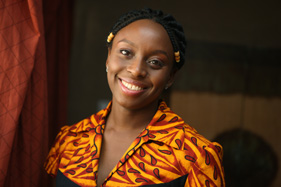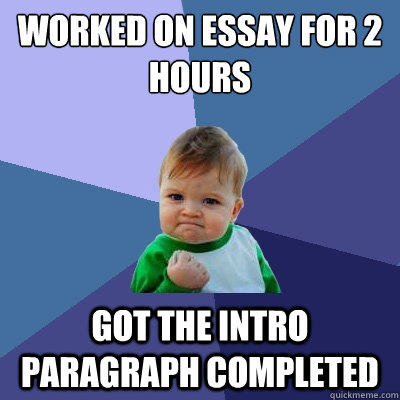Yes, she presents her pen name this way, without capitalization. Biographical information about this poet and thinker can be found at this link, and the main thing to know about her for our purpose is that she is a feminist, interested in the intersections between women's and African American identity.
Feminism, despite what you may have been told, is "the belief that men and women should have equal rights and opportunities" or is "organized activity on behalf of women's rights and interests." Feminism is not one big belief system with static rules; actually, it is a huge collection of on-going, evolving conversations. Some newcomers to the conversations become confused because the discussions include lifting up or recovering of items/behaviors/ideas coded as feminine, like vulnerability and intuition, and the like, AND the discussions also include arguments that people should break down binaries like masculine/feminine, vulnerable/impermeable, and logic/intuition.
Generally, there are three or maybe four recognized "waves" of Western, particularly American, feminism: a first wave (19th and early 20th century) that promoted women's suffrage and legal legitimacy in the U.S.; a second wave (1960s-1990s) that sought to advance women's access to contraception, education, and equal pay; and a third wave (1990s-present?) that seeks to incorporate causes of women of color, LGBTQIA+ populations, incarcerated populations, indigenous women, immigrant women, non-Christian women, non-Western women, and more populations that white feminism has previously overlooked.
hooks states,
“As all advocates of feminist politics know most people do not understand sexism or if they do they think it is not a problem. Masses of people think that feminism is always and only about women seeking to be equal to men. And a huge majority of these folks think feminism is anti-male. Their misunderstanding of feminist politics reflects the reality that most folks learn about feminism from patriarchal mass media.”hooks made headlines in 2014, when she referred to Beyonce as anti-feminist and as a terrorist, in a critique of Bey's use of feminism in her art/product media. So, here's where Beyonce enters the conversation.
The image above shows up 10 minutes and 20 seconds into Beyonce's performance at the 2014 MTV Video Music Awards, which you can view below. At that point in the music, words from Chimamanda N'gozi Adichie are featured in the song "***Flawless" and highlighted on the screen behind Beyonce:
We teach girls that they cannot be sexual beings in the way that boys are
We teach girls to shrink themselves, to make themselves smaller
We say to girls, you can have ambition but not too much
You should aim to be successful but not too successful
Otherwise you will threaten the man
Feminist, a person who believes in the social, political, and economic equality of the sexes
Beyoncé 2014 MTV VMA Video Vanguard (Medley) | Show Performance from terry.harden.mercer on Vimeo.
No matter what they think of Beyonce or hooks, for that matter, listeners cannot ignore that pop culture is involved in the conversations about feminism and African American women. More of the lyrics to the song "***Flawless" include the following:
I know when you were little girls
You dreamt of being in my world
Don't forget it, don't forget it
Respect that, bow down bitches (Crown!)
I took some time to live my life
But don't think I'm just his little wife
Don't get it twisted, get it twisted
This my shit, bow down bitches
Bow down bitches, bow bow down bitches (Crown)
Bow down bitches, bow bow down bitches (Crown)
H-Town vicious
H, H-Town vicious
I'm so crown crown, bow down bitches
...
You wake up, flawless
Post up, flawless
Ridin' round in it, flawless
Flossin' on that, flawless
This diamond, flawless
My diamond, flawless
This rock, flawless
My rock, flawless
I woke up like this
I woke up like this
We flawless, ladies tell 'em
I woke up like this
I woke up like this
We flawless, ladies tell 'em
Say I look so good tonight
God damn, God damn
Say I look so good tonight
God damn, God damn, God damn
Momma taught me good home training
My Daddy taught me how to love my haters
My sister told me I should speak my mind
My man made me feel so God damn fine, I'm flawless!
Whether or not readers agree that pop songs are poetry, they can still analyze them in the same way. Note the speaker (I), the significance of the diction, the allusions to her own life and to other cultural commenters (e.g. Adichie), the rhyme pattern, repetition, the fierce tone, and the encouragement to "ladies" who listen to accept themselves and not let others get them down. Notice also the layers of meaning in "I woke up like this"--remember, the theme of our poetry contest is "Get Woke." Here's an example of how others have analyzed the music and video of "Flawless."
To return to the world of poetry as it is more conventionally known, here is a work from writer Audre Lorde for you to read alongside Beyonce's lyrics:
Moon marked and touched by sun
my magic is unwritten
but when the sea turns back
it will leave my shape behind.
I seek no favor
untouched by blood
unrelenting as the curse of love
permanent as my errors
or my pride
I do not mix
love with pity
nor hate with scorn
and if you would know me
look into the entrails of Uranus
where the restless oceans pound.
I do not dwell
within my birth nor my divinities
who am ageless and half-grown
and still seeking
my sisters
witches in Dahomey
wear me inside their coiled cloths
as our mother did
mourning.
I have been woman
for a long time
beware my smile
I am treacherous with old magic
and the noon's new fury
with all your wide futures
promised
I am
woman
and not white.
These three authors' words leave readers and listeners with lots to think about. Here are some brainstorming questions to consider as you digest their works and follow the embedded links down the rabbit hole...
1. What new words or terms did these poems or quoted lines introduce you to? What are the terms denotations (formal definitions) and connotations (informal cultural, social, or personal associations)?
2. What common themes do these women writers and performers address in their works--be more specific than "feminism," "womanhood," or "the African American experience." Think deeper, perhaps along the lines of body consciousness, sexuality, community and solidarity, exploring/exploding binary thinking, certain imagery, etc.
3. Why is personal, subjective experience so important in these works?
As always, remember to point to specific words or phrases in the works to support claims you want to make.







